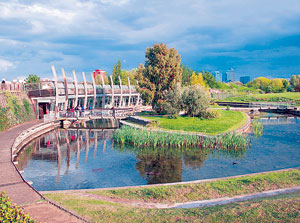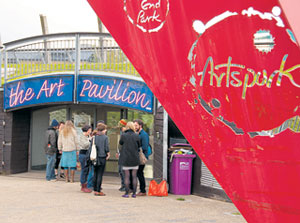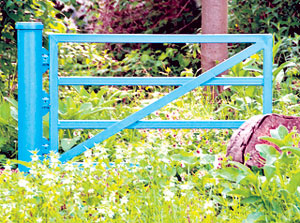Tingling trek through borough's spine
By Graham Barker. Photos by Mike Askew
28 June 2010
Download the walk offline route and map
Mile End Park runs like a green spine through the borough. As well as its ecological park, art pavilion and playgrounds, it has many hidden green corners.
And at this time of year it’s a natural haven, full of wild flowers, bugs, water lilies and birdlife. Whether you’re looking for peace and quiet, a play space or a picnic spot, it’s a lovely place to wander about.
We start this month’s walk at Mile End Underground station. Exit the station, turn left and at the lights cross the busy Burdett Road. Ahead, you’ll see the green bridge (1) – a planted walkway with yellow underbelly, constructed in 1999 to connect both halves of Mile End Park. At the two-tone signpost, head left up steps beside the green glazed tiles. Already the traffic noise softens.
On the bridge, slope down left with the wide path, past a red milepost with a parade of turbine-topped lights beyond. Beside the canal bridge, the history panel (2) tells how the park was created from bombed-out streets and factories. Keep left, on the gritty pedestrian track as it snakes beside trees and wild flower pastures.
The footpath slopes up, giving views across the adventure playground (3) – with a huge spider’s web climbing frame – and youth outreach centre. Continue ahead, past the sports pitches and running track of Mile End Stadium (4), to the park gates.
Our route leaves the park briefly here. However, if you fancy clocking up an extra half-mile or so, then tag on a visit to the skateboard park, go-kart track and young children’s playcentre. They’re worth a detour, especially if you have children – to find them, skirt left around the mural-fronted stadium and running track and head through the railway arch by all-weather pitch 4.
Back at the main park gates, spot the heraldic King George V Fields plaques (5) carved into Portland stone. Cross Copperfield Road to the Ragged School Museum (6) – opened by Dr Barnardo to provide free education and meals to poor and orphaned children. Walk left behind the museum, through a brick arch and down steps to join the Regent’s Canal.
Follow the towpath as it runs north, past Johnson’s Lock, new apartments and converted warehouses. As you stroll, look out for swans, coots, moorhens, ducks and geese. After banked flower meadows, head first under a brick footbridge and later under Mile End Road. Beware of cyclists and don’t bash your head on the low arch.
Continue past the New Globe Inn steps and Mile End Lock (7). The metal-clad halls of Queen Mary University (8) sit across the canal. And in the summer months, you can hire a punt here to experience the canal first-hand. Stick on the towpath – don’t worry, we’ll come back to explore the enticing park features on our way back.
Walk under the railway and past blue-bricked Mile End Climbing Wall (9) – pitched at novice climbers and professionals alike. After the elegant sweep of Meath Bridge and the Palm Tree pub – a popular oasis – pause on the wooden platform to survey the ecological park, currently flourishing with water lilies and reed beds.
Keep on – past the quirky orange fishtail sculpture – and head under Roman Road. Before the brick gable slope right, past a small wooded area where young children can play out their stories using the blue ‘gate to anywhere’ and orange ‘there and back’ arrows.
Across the green – known as Wennington Gardens – sit the pale yellow Victoria Park Baptist Church, the sunbeam-windowed former Barnardo’s home, and the patterned brickwork of St Barnabas Church. Give the open-air gym (10) a try, before heading right, back under Roman Road.
At the sculptures, take the rightmost of three paths and head right over wooden bridges and through the ecological park (11), home to grey herons, water boatmen and red damselflies. Continue over woodchip – skirting the Palm Tree car park – and re-join the towpath. Head left and immediately beyond the railway, curve on the rightmost of three paths over the Arts Pavilion (12), with a fine view of the university.
Walk down the pavilion’s grassy slopes to Chris’s Wood (13), marked by an inscribed boulder. A short way along, fork right and spiral around the mound (14) – reputedly the highest ‘natural’ point in Tower Hamlets. A panel at the top tells of the New Globe Tavern’s 19th century pleasure gardens here.
Now head down the wood-fronted steps and up onto the green bridge, your final climb. Look south to Canary Wharf, with the flag-flying tower of St Anne’s Limehouse just visible. Just before the Dalek-shaped vent, curve around the green tiled terrace, overlooking tiered ponds and gardens (15) – surprisingly peaceful yet just a stone’s throw from Mile End Road.
Back at the vent, take the right-hand path to explore the stepped gardens before returning to Mile End Tube station, the end of our walk.
With thanks to the St Stephen’s Health Centre walking group – Anwara, Chris, John, Julianne, Kamrun, Saleha, Steve, Thea, Toni and Zahra – for trialling this walk.
Become a Facebook Friend of Mile End Park
Mile End Park hosts a full programme of events over the year. These range from exhibitions at the Arts Pavilion to children’s events such as water festivals, Easter egg hunts, cardboard city and Halloween’s Park after Dark. To find out what’s going on, call the rangers on 07951 321051 or keep up to date by becoming a friend at www.facebook.com/mileendpark
Park patron Joanna Lumley has recorded an audio walk around Mile End Park. You can download it at www.towerhamlets.gov.uk/mileendpark.
Download the walk offline route and map